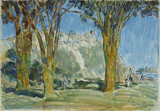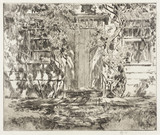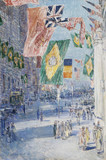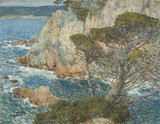Frederick Childe Hassam was one of America’s earliest and most significant impressionists. During his long and productive career he produced a tremendous body of work in oil paintings, watercolors, pastels, etchings, drypoints, and lithographs. He painted predominantly landscapes and cityscapes, often depicting his beloved New England, although he also painted figurative scenes, particularly later in life.
Hassam’s unusual family name is that of a very old New England family. He began his career as a book illustrator in Boston. After his first visit to Europe in 1883 he returned home to paint tonalist views of that city. In 1886 he moved to Paris, where he lived for three years. There he enrolled at the Académie Julian, studying with Jules Lefebvre (1836-1911), and continued to paint cityscapes, his palette becoming increasingly paler and his brushstroke more impressionistic in response to French styles. Returning to the United States, he settled in New York but continued to summer as before in Appledore, on the Isle of Shoals off the coast of Maine. In 1896 Hassam began working at Cos Cob, Connecticut, no doubt inspired to go there by his friendships with other American impressionists. During the same decade he became an active exhibitor in annuals throughout the country and participated in artists’ organizations, becoming the first president of the American Water Color Society and a member of the Society of American Painters in Pastel and the Players Club. He spent 1896-98 traveling in Italy, Brittany, and England.
Upon his return home Hassam. exhibited in the first exhibition of the secessionist group Ten American Painters, which he was instrumental in organizing. In 1900 he expanded his subject matter, depicting Manhattan views, New England churches, laborers at work, and nudes. He first visited Old Lyme, Connecticut, in 1903, and his continued presence there transformed the art colony from a Barbizon-dominated group to an impressionist one.
In 1904 and 1908 he visited the West Coast at the invitation of his patron, Colonel Charles Wood of Portland, and painted in eastern Oregon. In 1914 he worked in San Francisco and environs. In 1910 he began to visit eastern Long Island and in 1919 bought a summer home in East Hampton, which would serve as the locale of many of his paintings during his last fifteen years. In 1915 he began his printmaking career. Hassam. bequeathed the works in his estate to the American Academy of Arts and Letters, of which he had been a member since 1920.
BIBLIOGRAPHY
New York, American Academy of Arts and Letters, Childe Hassam Papers (on microfilm, Archiv. Am. Art) § Index 20th Cent. Artists 3 (October 1935): 169-83; 3 (August- September 1936): 1; reprint, pp. 461-75, 477 § Adeline Adams, Childe Hassam (New York: American Academy of Arts and Letters, 1938), with lists of awards and collections § Donelson F. Hoopes, Childe Hassam (New York: Watson-Guptill, 1979), with chronology, bibliography § East Hampton, Guild Hall Museum, Childe Hassam, 1859-1935, exh. cat., 1981, with essays by Stuart P. Feld and Judith Wolfe, chronology by Kathleen M. Burnside.




